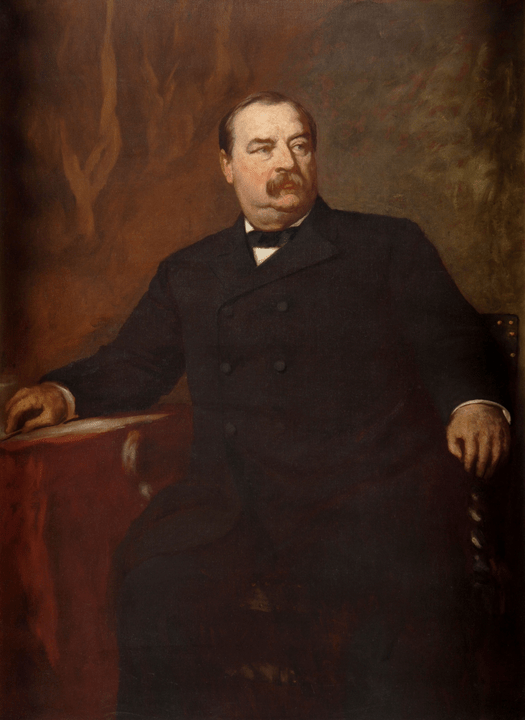Grover Cleveland, who served as President of the 22nd and 24th United States, was regarded as a constitutional reformer (1837-1908). He is the only president to date who served two non-consecutive terms, as well as the only Democratic president to win elections during the era of White House Republican rule that lasted from the election of Abraham Lincoln in 1860 to the end of the term of William Howard Taft in 1913.
First Term in the White House
Tammany Hall was a local political machine of the Democratic Party. He played a significant role in controlling the New York State politics. He greatly opposed Grover Cleveland’s nomination; however, Clevelnd secured the Democratic presidential nomination in 1884. The 1884 presidential campaign was ugly: the Republican adversary of Cleveland, the U.S. A variety of financial scandals involved Senator James G. Blaine of Maine, while Cleveland was involved in a paternity case in which he acknowledged that in 1874 he had paid child support to a woman who claimed to be the father of her child. Cleveland won the race, amid the controversy, with the help of the Mugwumps, Republicans who found Blaine to be corrupt.
When in office, Grover Cleveland tended to base political appointments on merit rather than party affiliation, the policy of his predecessor, Chester Arthur. Using the veto more frequently than any other president up to that time, he sought to limit government spending. In foreign policy, Cleveland was a noninterventionist and fought to eliminate protective tariffs.
The lifelong bachelor married Frances Folsom in 1886, a student at Wells College in New York. He is the only one who held the wedding in the White House, while Grover Cleveland was not the first president to marry while in office. Frances Folson was the youngest first lady in U.S. history at the young age of twenty-one. They were blessed with five children.
By vetoing the Dependent Pension Bill of 1887, which would have offered pensions for disabilities not induced by military service, he offended voters in 1887. His other significant contributions were the Interstate Commission, which is the first regulatory agency of the United States. He also signed the Dawes General Allotment Act which provides a distribution of land for Native Americans.
In the 1888 presidential race, the tariff debate came back to haunt Cleveland. The election was won by former U.S. Senator Benjamin Harrison of Indiana, primarily because of the strong turnout of voters in the Northeast industrial states who saw their jobs threatened by lower tariffs. In that election, Cleveland also lost his home state of New York. He returned to New York City and, for the next four years, took a job in a law firm.
Second Term in the White House
Grover Cleveland spent four years in New York City during the Harrison administration, working with a renowned law firm. The path to a Democratic victory in 1892 appeared obvious when the Republican-dominated Congress and the Harrison administration implemented the very high McKinley Tariff in 1890 and made the surplus in the treasury disappear in a huge spree of spending.
For the third consecutive time, Cleveland secured the nomination of his party and then defeated Harrison and Populist Party nominee James B. Weaver soundly by 277 electoral votes to Harrison’s 145, making Grover Cleveland the only president ever elected to two nonconsecutive terms.
However, Grover Cleveland’s second term opened with the worst financial crisis in the history of the world. With a railroad bankruptcy in February 1893, the Panic of 1893 began, immediately followed by bank defaults, a national credit crisis, a stock market collapse, and the failures of three more railroads. Unemployment increased to nineteen percent, and the coal and transport industries were disrupted in 1894 by a series of strikes. Until 1896 to 1897, when the Klondike gold rush in the Yukon set off a decade of rapid growth, the American economy did not recover.
Grover Cleveland was contradictory in his social beliefs. He was opposed the discrimination against Chinese immigrants in the West, on the one hand, he advocate equality for African Americans or women’s voting rights, and he believed that Native Americans should assimilate as soon as possible into mainstream society rather than maintain their own cultures. When he used federal troops to crush the Pullman railroad strike in 1894, he also became unpopular with organized labor.
As a president, Grover Cleveland served with honesty and diligence; however, he was blamed for being dull and does not have an overall vision for the nation. He is best known for improving the federal government’s executive branch with respect to Congress, as opposed to using legislation to bring about social change.
By the fall of 1896, with some factions of his own party, Cleveland had become unpopular. However, other Democrats wanted him to run for a third term, since at the time there was no term limit for Presidents. Cleveland turned down the offer. The nomination was won by Representative William Jennings Bryan of Nebraska. William Bryan, who later became popular as an opponent of the theory of evolution of the British naturalist Charles Darwin, lost the election to Ohio Governor William McKinley in 1896.
After leaving the White House in 1897, Grover Cleveland returned to his home in Princeton, New Jersey, and served from 1901 until his death as a trustee of Princeton University. He declined his party’s overtures to run for president again in 1904. At the end of 1907, his health started to decline rapidly and on June 24, 1908, he died of a heart attack at the age of 71.
US Presidents | ||
